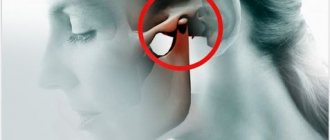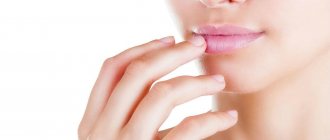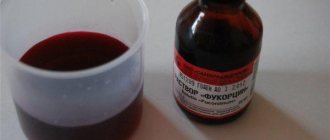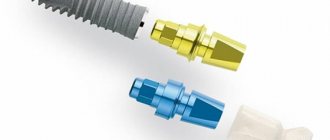598
It is not at all difficult to imagine a person who, in his entire life, has never suffered from, say, heart or kidney disease.
But it is unlikely that there will be an individual who, throughout his entire life, has never experienced problems with his teeth, has not suffered from pain, or has not sought the help of a dentist, surgeon, orthopedist or orthodontist.
Bad teeth are incompatible with a high quality of life. Meanwhile, maintaining their health is not so difficult.
Intact – what is it?
What is an intact tooth in dentistry? Translated from Latin, intactus means “untouched.” Accordingly, an intact one is one that is intact, healthy and not affected by any inflammatory processes or diseases. Hearing this term in relation to his teeth after a preventive examination, the patient should rejoice. You can experience twice as many positive emotions if the doctor says that you have an intact dentition, because this means that all the elements in the row are healthy.
Important! The term can be applied not only to the whole tooth, but also to its individual components and structures - enamel, crown, root, periodontal tissue. The doctor may also use a phrase such as intact surface, but this does not mean at all that the tooth is healthy - it may be affected by caries, pulpitis or periodontitis, but at the same time, areas not affected by infection or destructive processes remain.
Rules for maintaining oral health
The main preventive measures against the development of dental diseases are proper oral hygiene and regular visits to the dentist.
Teeth do not become sick instantly. It takes a certain amount of time for an intact unit to become carious or pulpitic.
Regular visits to the dentist once every 3-6 months allow you to promptly notice signs of trouble and take preventive measures to stop the development of the disease.
Demineralization of enamel, the presence of soft and hard plaque, increased tooth abrasion, malocclusion creating periodontal overload - all these signs will be detected by the doctor during examination, and treatment or preventive measures will be prescribed. As a result, the development of an unfavorable situation will be stopped, and the unit will remain intact.
Good oral hygiene is considered the main condition for keeping teeth healthy. Over the past centuries of development of scientific dentistry, the causes and mechanisms of dental diseases have been studied in sufficient detail. It has been established that in most cases, poor oral hygiene is the main cause of dental disease.
Food debris that is not removed from the oral cavity becomes a breeding ground for cariogenic bacteria. Acids produced by microorganisms corrode the enamel, forming a carious cavity, which, spreading deeper and wider, destroys the tooth crown, reaches the pulp chamber and inflames the pulp, leading to the need for depulpation.
The fight against caries and tooth decay should begin with mastering proper oral care. The main goal of hygiene is to prevent the formation of plaque (plaque), which involves regular brushing of teeth with a brush and toothpaste.
Cases in which intact surfaces have to be prepared
Installation of veneers and lumineers
Doctors always resort to preparation of hard tissues before installing prostheses. Even if you are just going to install veneers or ultraneers to hide the unsatisfactory shade of enamel and diastema, you need to be prepared for grinding. The frontal surface, even if it is completely intact, will be subjected to minor preparation. How much fabric will need to be sewn? Everything will depend on the thickness of the lining, approximately 0.3–0.8 mm.
On a note! If you decide to improve the aesthetics of the smile area with the help of artistic restorations with a composite, to hide the diastema (interdental gap), for example, then the doctor will also carry out a minor preparation of the frontal surfaces of the anterior units so that the filling materials fit better to them.
You will have to grind the enamel the least if you choose lumineers. However, the doctor will still have to lightly sand it down to a thickness equal to the thickness of the onlay (about 0.3 mm) to ensure high quality fixation and a natural smile.
Prosthetics with bridges
An intact tooth can act as a support tooth for bridge prosthetics. And before installing the structure, it will have to be very thoroughly prepared; trephination (opening) of the crown will be carried out and the pulp will be removed.
Treatment of pulpitis and periodontitis
The physician may touch an intact surface, such as the palatal surface, when treating pulpitis or periodontitis on incisors or canines in order to provide access to the coronal portion of the pulp and root canal orifices. It is not possible to do this from the front side of the cutting edge, since then there is a risk of spoiling the natural shape, aesthetics and functionality.
Bite correction
It is necessary to touch the intact surfaces of some teeth when carrying out a procedure such as separation (grinding). Most often it is used in orthodontics if the bite pathology is minor. The procedure helps to avoid removing some elements of the row. During the process, the doctor grinds off the enamel from the side surfaces and can free up up to 5 mm of space on the jaw.
Prevention measures
All various preventive measures that help keep teeth healthy can be divided into 4 groups:
- Regular visits to the doctor.
- Proper oral hygiene.
- Power control. Providing the body with nutritional components that ensure the proper development of the dentofacial apparatus. Acceptance or, on the contrary, exclusion of those products that, by their physical form, are beneficial or harmful to the condition of enamel and dentin.
- Improved overall health.
Visiting a doctor for preventive purposes
As already noted, you need to visit the dentist at least 2 times a year. The optimal frequency is considered to be once every 3 months. During a preventive examination, the doctor will definitely notice the onset of the disease and take the necessary measures.
Reasons for performing dental trepanation and the specialist’s course of action.
In this publication we will discuss the importance of photodynamic therapy in dentistry.
Here https://www.vash-dentist.ru/lechenie/zubyi/lidoksor-partner-stomatologa.html all the most important things about the drug Lidoxor.
Oral care
You need to brush your teeth at least 2 times a day: the first time in the morning after meals (you can rinse your mouth before breakfast), the second, mandatory time, in the evening after dinner. Pre-night cleaning is more important than the first, because if it is not done, food debris will remain in the oral cavity for a long time.
To clean the proximal space, you need to use brushes and floss.
You should begin and end brushing by rinsing your mouth with mouthwash or clean water.
The brush is changed once every 2-5 months , the paste - every 1.5-2 months. The bristles should not be very hard, suitable for enamel and gums, the brush head should not be traumatic. It is advisable to periodically use specialized pastes with fluoride, calcium, triclosan, whitening, and medicinal herbs.
To clean MVPs and orthodontic appliances, it is recommended to use superflosses - thinner threads of a special structure.
You also need to clean your tongue with a special scraper.
Do not use foreign objects, such as needles, for cleaning. Even toothpicks should be used carefully, without excessive zeal, so as not to damage the enamel or injure the gums.
Nutrition
Food must contain all the components necessary for the body. Too sweet and sour foods are considered harmful to enamel and dentin; it is advisable to reduce their intake.
The menu should contain not only soft, but also fairly hard foods that partially cleanse the teeth of soft plaque and create a healthy load for them. At the same time, too hard (nuts, crackers) and viscous (toffee) foods should be excluded from the diet.
General health
It has been established that there are cause-and-effect relationships between caries and certain diseases and conditions. Susceptibility to caries increases with Kashin-Beck disease, hypothyroidism, rheumatism, and changes in hormonal status.
Pregnancy is a predisposing factor to caries. Radiation therapy used in the treatment of tumors of the head and neck is very dangerous for the condition of enamel and dentin.
Heredity also influences a person's susceptibility to caries.
The exact mechanism by which general health affects dental health is not fully understood. However, it is assumed that the connection between them is determined by the pulp, which contains blood vessels that feed dentin and enamel, the composition of the oral fluid and the condition of the periodontium.
For all of the above cases, special preventive measures have been developed that reduce the risk and severity of mediated dental diseases. They should be used on the recommendation of a doctor.
Learn how to keep your teeth healthy from the video.
Orthodontic bite correction
There are often clinical cases in which, before treating malocclusions with braces or aligners, some teeth must first be removed. This is done to free up free space on the jaw. In this case, the intact tooth itself may have a normal location, but it has to be sacrificed. Often the third molars are removed, less often the second and first ones.
On a note! The definition of intact is a tooth that is not affected by dental diseases such as caries, pulpitis or periodontitis. However, it may be curved, occupy an incorrect position in the row, be supernumerary, or have signs of macrodentia (crowns that are too large in size) or microdentia (small crowns).
If the unit is intact or has an oversized crown, it will most likely have to be removed before braces can be placed.
vegetable tanned leather, aniline, patent leather, tanning technology
When choosing leather furniture, you need to understand what material it is made of. Does it need to be handled with care or can you relax and rely on its strength and durability?
On the picture:
Leather technology
For centuries. Before “living matter” becomes the upholstery of a sofa or chair, the leather must undergo intensive processing. Only in this case will it not rot, become soft and last for many years.
The vast majority of furniture upholstery (hides, suede, leather) are made from cattle hides. Luxury leathers are obtained from animals raised in a special way. For example, females should not have offspring (otherwise the skin will stretch). And male bulls must graze in the safest possible conditions: so as not to be scratched by branches or thorny fences.
Processing of raw hides
Preparatory stage. After removing hair and fat, the skin is cut into two layers in thickness. The top one is of higher quality. By nature itself it is designed to withstand loads, friction, and the vagaries of the weather. The lower layer of skin - split - is less durable. It can be determined by the presence of hard particles. At equal thickness, the first layer is ten times stronger than the second. For furniture upholstery, it is usually the top layer of material that is used. By the way, thickness is one of the bases for classifying leather by cost.
On the picture:
You can evaluate the thickness of furniture leathers and the quality of workmanship using samples of upholstery materials that are available in each salon.
Leather tanning. The first and main stage of processing. This is a kind of preservation of raw materials: high-quality skin can be stored for centuries. Two types of tanning are known.
The ancient and most common today is vegetable. It involves treating leather with tannins - acids of natural origin. They are extracted from certain types of wood: oak (hence the tanning), mimosa, walnut. Vegetable tanned leather is a completely natural product.
The second type of tanning involves the use of chromium compounds. These chemicals give leather greater strength and durability than tannins. They will not cause serious harm to the human body. However, problems arise at the furniture disposal stage. That is why leading European manufacturers abandoned chrome tanning.
On the picture:
The process of chrome tanning with simultaneous dyeing of leather in a factory.
Skin coloring
Lacquer or aniline? To make one chair, the skins of several animals are required. Naturally, they cannot perfectly match each other in shade.
To achieve a color match, the skin is dyed. After the paint dries, the material is stretched - so it becomes soft and pliable.
Depending on the type of pigments used, aniline, semi-aniline and patent leather are distinguished.
On the picture:
Scratches, cracks, abrasions are the signs by which true connoisseurs distinguish aniline leather.
- Patent leather is the exact opposite of delicate aniline leather. This is a durable material, impregnated with dye and filled with a layer of colored varnish. It does not require special care, and feels harsh to the touch. Such skin is not afraid of sweat, moisture, or fat. It is used to make bed podiums that must be regularly stepped on, decorative inserts into tabletops...
On the picture:
There are no “natural” leathers that are bright yellow or scarlet in color with a glossy surface. Most likely this is patent leather.
Leather embossing A technologically important stage in leather tanning, which is not always necessary. Embossing is used only for simple raw materials with a sanded “face”. Before applying a pattern to the surface, it will have to be perfectly leveled, i.e. remove natural pattern. Then from an ordinary cow you can make even a python, even a crocodile. Or create an intricate floral pattern on the surface of the leather.
In the photo: model Cerbero Rosa 2014/H - Ruggine from the Rodeo factory.
- Semi-aniline leather combines the advantages of aniline and patent leather. First, it is treated with aniline dye, which penetrates the pores, then a transparent protective layer of varnish is applied. The natural texture of the material is preserved, but wear resistance increases.
- Aniline leather is the most delicate, “unprotected”. Natural translucent compounds are applied to the skin. Over time, they fade in the sun, and a noble network of wrinkles appears on the surface (natural aging). Some leathers are “helped” to age by manufacturers - artificial abrasions are now in fashion. The range of aniline dyes is limited - only natural shades. The material is chosen only by true connoisseurs of beauty.
On the picture:
Semi-aniline leather retains its natural pattern; the dye penetrates into the pores without forming a film on the surface.
The oldest paper The quintessence of patent leather is parchment (aka parchment). The material is so thin that without a dozen or two protective layers it will not last even a couple of days. And after processing it looks more like stone. Parchment is used for cladding the facades of cabinet furniture and countertops.
Why remove intact milk units?
This must be done in cases where the time frame for changing milk units to permanent ones is delayed. At the age of 7–8 years, permanent teeth begin to erupt, but temporary teeth should begin to fall out, but not all children have this process smoothly.
It also happens that the dairy ones, due to excessive mineralization or due to the individual characteristics of the body, do not even wobble, although the rudiments of permanent ones are already resting on their roots.
If such elements are not removed in a timely manner, the permanent ones may make their way into the second row. This can cause crowding and malocclusion in adulthood.





